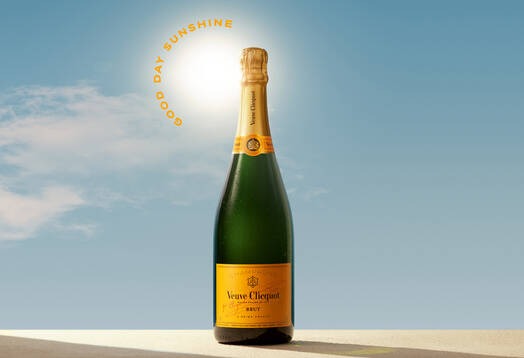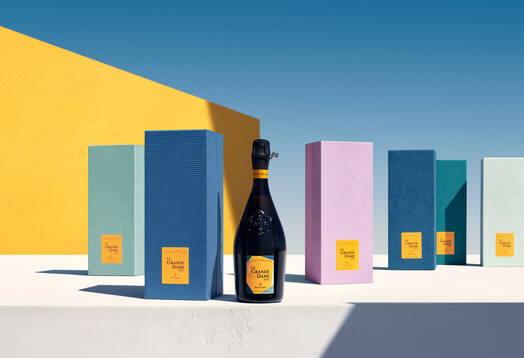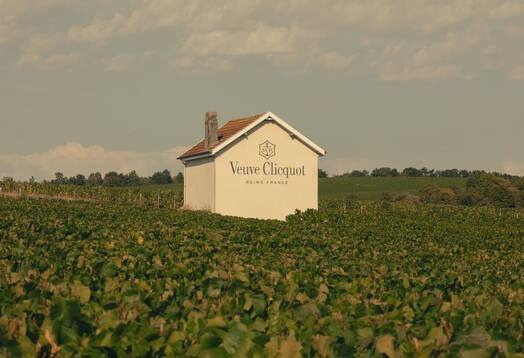VERZY'S VEGETABLE GARDEN
The Verzy's Vegetable Garden is an adventure – of the earth, the plants and all these men and women, gardeners, winegrowers, cooks, engineers, managers and communicators, who meet each other here and work together.
A testing ground of exploration and innovation, more than 300 permaculture varieties will be used in the creation of food and champagne pairings for a new era.
A testing ground of exploration and innovation, more than 300 permaculture varieties will be used in the creation of food and champagne pairings for a new era.

Cooking a daily menu made only from seasonal ingredients, freshly harvested at the crack of dawn, is a great pleasure. We become mindful in our simplest gestures, as if in tribute to these marvels of nature. The intensity of the flavours and the care taken over preparation amplify the elegance of La Grande Dame.

We took our inspiration from the first drawings of the potager of the Manoir de Verzy, dating from 1920, to restore the garden and turn it into a sensory, food-lovers’ walk. Plant species have all been selected according their botanical and gustatory interest.

La Grande Dame and Garden Gastronomy are intimately linked. Both are born from the earth and of human toil. They remind us of the cycles of the seasons, the excitement of harvest-time, the pleasure of tasting fruits plucked from the plant or vine to understand the particularities of a soil or of a ‘vintage’.
DISCOVER THE INTERACTIVE MAP
This is not just a potager… You are entering a garden whose scope is much vaster than that of a simple production space. On more than 2,500 square metres, over 300 plant species have been carefully cultivated, cohabiting with the earthly microcosm that was already present.
Click on the magnifying glass to zoom
Navigate in the map, then click on the points to discover the vegetable garden
Click on the dots to discover the vegetable garden


Kales
Brassica oleracea. Brassicacée.
Kale, or leaf cabbage, is an old variety representing several species such as the Noir de Toscane or Westlandse Winter. They are frost-hardy and do not produce a head but are harvested leaf by leaf. As well as its antioxidant and anti-inflammatory properties, kale is rich in proteins, iron, vitamins (A, K and C), minerals, omega 3 and 6 and beta carotene – its nutritional value is so impressive that it is recommended for daily consumption
Kale, or leaf cabbage, is an old variety representing several species such as the Noir de Toscane or Westlandse Winter. They are frost-hardy and do not produce a head but are harvested leaf by leaf. As well as its antioxidant and anti-inflammatory properties, kale is rich in proteins, iron, vitamins (A, K and C), minerals, omega 3 and 6 and beta carotene – its nutritional value is so impressive that it is recommended for daily consumption

The squash patch
Squash, with its countless shapes, colors and sizes, refers to four species of plants in the cucurbit family, commonly cultivated for their edible fruits.
By observing the hardness of the peduncle, one can ensure the good ripeness of the fruit.
Harvested and later dried under the sun all day, squash can be stored all winter in a dry and warm place, ideally at home, until April.
By observing the hardness of the peduncle, one can ensure the good ripeness of the fruit.
Harvested and later dried under the sun all day, squash can be stored all winter in a dry and warm place, ideally at home, until April.

Physalis
The physalis species includes more than 200 perennial and annual species.
This perennial plant offers bakers red-orange round berries with a sweet, sugary and slightly sour flavor. Physalis are grown similarly to tomatoes but with a later harvest from August to October.
Rich in vitamins A, B, C and betacarotene, the berries should be enjoyed in moderation!
This perennial plant offers bakers red-orange round berries with a sweet, sugary and slightly sour flavor. Physalis are grown similarly to tomatoes but with a later harvest from August to October.
Rich in vitamins A, B, C and betacarotene, the berries should be enjoyed in moderation!
AT THE ORIGIN OF THE VEGETABLE GARDEN
Domaine of Verzy
The Manor and its park occupy a special place on the heights of the vine-clad slopes of the village of Verzy, where the historic Grand Cru vineyards bought by the founder of the House, Philippe Clicquot, and by his daughter-in-law, Madame Clicquot, are found.
The Manor of Verzy was occupied by Bertrand de Mun, the future director of the House from 1907 to 1950, who had a vegetable garden laid out on the same spot where the Potager Clicquot has now been created.
The Manor of Verzy was occupied by Bertrand de Mun, the future director of the House from 1907 to 1950, who had a vegetable garden laid out on the same spot where the Potager Clicquot has now been created.

“Grands crus” vegetables for grands crus grapes.
Winegrowing has changed a lot in recent years, with a very strong focus on sustainability.
This is how the idea of the potager emerged, with the desire to produce fruit and vegetables locally, which are then cooked by our chefs at the Hôtel du Marc, or donated to charitable organisations in case of surplus.
DISCOVER LA GRANDE DAME This is how the idea of the potager emerged, with the desire to produce fruit and vegetables locally, which are then cooked by our chefs at the Hôtel du Marc, or donated to charitable organisations in case of surplus.




